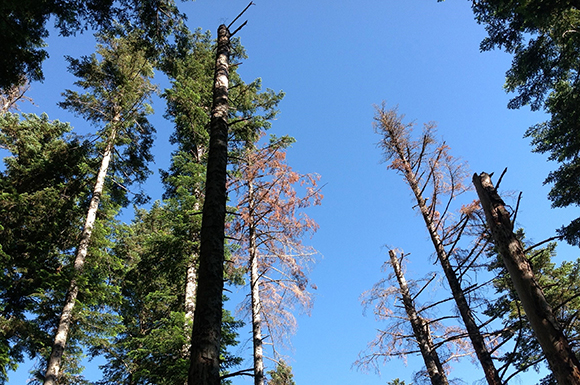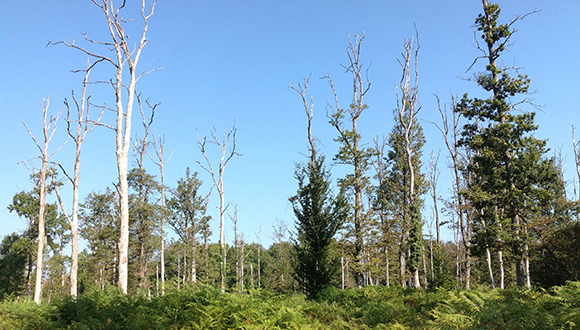The forest fate: winning time
What is the future that the Mediterranean forests expect? Climate change is already strongly felt and its impacts reach everywhere. Francisco Lloret tells the current situation and how we will have to prepare ourselves and forests to the coming changes .
![]()
For Craig and Seva.
Craig Allen is a good friend who has become famous. In 2010 he published a compilation of 88 recent cases of massive tree mortality in forests worldwide. Since then the subject has become a trending topic of ecological scientific literature. Indeed, there is evidence that in many cases this mortality is related to climate change since it coincides with severe episodes of drought or heat waves. The phenomenon is not geographically unique, but it occurs in different biomes, from tropical to boreal forests including temperate and Mediterranean ones.

In the Iberian Peninsula, we find episodes of tree mortality in pine forest of P. halepensis, P. nigra and P. sylvestris, in Abies alba and A. pinsapo forests, in Quercus ilex and Q. suber woodlands. Die-off also occurs Mediterranean shrublands, despite their adaptation to more arid conditions. So, generalized mortalities have occurred in shrub formations of Spanish Levante, Central Ebro valley and Andalusia, in line with die-off in Californian chaparral. The forms in which this decay occurs are also varied. In some cases, such as in oaks, the leaves turn brown and fall, but trees resprout when rains return, unless trees grow over skeletal soils. In others, such as in Juniperus sp pl or Nothofagus sp pl from the Andean Patagonia, the loss of leaves mainly affects some branches that eventually remain dry. In many conifers, such as firs, pines and pinsapos, the whole tree dies in a few years.
But things are rarely simple in nature. Although we often see a drought climatic signal, this may correspond to a very specific temporal event. The heat wave of 2003 summer caused a loss of forest cover in western and central Europe that resulted in a 30% decrease in the European primary gross production. Tens of thousands of human deaths throughout Europe, particularly in France, have been attributed to this event.

Episodes of forest mortality can also occur after longer periods of drought, as in the P. sylvestris forets in the Sierra de Prades in Tarragona, or in the shrublands of the Ebro central valley. Sometimes drought is combined with very low winter temperatures, as happened in Doñana in 2005. Recently the SE of the Iberian Peninsula has experienced a prolonged drought lasting several years that recently merged with cold temperatures. We will see soon the consequence of this combination on the thermophilic scrub that live there.
The spatial distribution of mortality is also diverse. In the forests of Pinus edulis of North America, in the oakland and the chaparral of California, in the eucalyptus savannas of Australia, affected areas cover hundreds or thousands of square kilometers. In Europe, the extensions are not so large and the percentages of dead trees are lower, perhaps because here we have more fragmented landscapes and relatively young forests. For example, a contact between a fissured rock - in which the roots can penetrate - and a compact rock can make the difference between mortalities over 75% and less than 25%, as we observed in Holm oak forests of the Serralada Prelitoral de Catalunya in the 1994 drought.
Often, drought is not the only factor causing these mortality episodes. In many cases, the factors conducting to these mortality episodes are multiple and vary from site to site. This contributes to explain the variety of situations that we observe. Thus, it is often difficult to attribute the contribution of different drivers to forest mortality.

Some scientists claim that the main cause of tree death trees is the attack of insects, fungi and other pathogens, leaving aside human action or natural disturbances. Commonly, these attacks combine with climate, and in particular with drought conditions. A tree that suffers stress due to water scarcity will diminish its defenses against insect attack. And vice versa, a healthy tree whose defenses are pierced by the pathogen will be more vulnerable to the drought stress. These interactions between climate and pests or pathogens can be complex, for example because they are modulated by the climate variability over several years. They may also produce counterintuitive situations. The fungi that cause cork oaks decay in Andalusia and Extremadura love wet conditions, but dry years also kill trees.
Faced with this wide variety of situations and factors contributing to forest mortality, we might think that we are not able to predict what will happen to forests, at least as far as climate change is concerned. Some people argue that in the face of scientific uncertainty, we better do nothing. But this postulate is misleading because, as in so many arguments of little foundation, the part is taken for the whole. Uncertainty is not an absolute. We can not know if a neighbor forest will suffer a plague in the next ten years, but we know with very little uncertainty that in the near future it will be subjected to high temperatures, without increasing rainfall, at least in our region. We have very little doubt that our descendants will live in a more arid climate.
This is important for management because forests are slow to grow. The functioning of forests resulting from the current management will take place in a climatic context different from the present one. Therefore, it does not make much sense to plan about forests assuming the current climatic conditions. Slowly, this idea so simple, but so difficult to execute, is arriving to the involved people and sectors.

Therefore, if our future forests will live in more arid conditions, their permanence is compromised. We all know that plants need water to live. If it does not rain and we do not water the pots, the plants on the balcony die. No wonder that in a region, such as the Mediterranean, which is adjacent to semi-desert regions without extensive forests, if aridity increases, forests will cease to exist, at least in a generalized way. Biogeographers know that forests live in regions that are not excessively dry or cold. Future predictions indicate that the climatic conditions necessary for trees are unlikely in many areas of the Iberian Peninsula. Scientific evidence says that in the medium-term future - we are talking about a few human generations - there will be fewer forests in our environment. That is the fate of our forests.
What can we do if our forests are doomed to disappear? The first thing is to become aware. We will be better prepared emotionally and we can see the positive side of the situation. For example, many forests will be replaced by scrublands, which require less water. Bushes have some bad reputation and they have often been considered as degraded landscapes. Some are actually the result of human actions that are not very respectful and reflect the eagerness of vegetation to persist in landslides and rubbish.
But many scrublands are rich in biodiversity. The typical vegetation of the different Mediterranean regions of the world are shrublands rich in species. We need to recognize shrublands’ values. Especially for practical reasons, as they provide essential services such as soil protection and regulation of water flows, just as forests do. We know that the loss of vegetation cover is a key process leading to the greatest losses of functionality in terrestrial ecosystems, no matter whether cover comes from trees or shrubs.

The next thing is that forests can remain in wet refuges or in sites where soils are able to retain more water, in spite of a generalized loss of forest cover at regional level. However, changes in species composition and tree density will likely occur. In other words, we need an integrated landscape-based management of forests considering future scenarios. To do that, we need maximize the possibilities offered by the heterogeneity of the territory and apply our knowledge about forests functioning.
Of course, we can also consider irrigating the forests, at least locally. This idea may seem bizarre, but technologically it would be relatively affordable compared to other infrastructures that are built in the territory. Historically we know that irrigation works, for instance when we see in the chestnut groves in impossible slopes of Andalusian Alpujarras, where Arab settlers built ditches. At least we could incorporate the idea in the portfolio and calculate its feasibility, taking into account that water will be more scarce in the future.
However, many forests are doomed to disappear due to climate change, probably aided by fires and pests. Faced with this fate we could cross our arms with the argument that it is irremediable. But this is not the attitude of most ecologists and foresters. Indeed, can do something important: gain time. It may seem like a resigned attitude, but in reality it is rather more. At the end of the day is what doctors are dedicated to. Medicine basically seeks to delay the moment of inexorable death, and we value it - unless that prolongation of life bears suffering.

Gaining time can allow us several things. On the one hand, to ensure the adequacy of forests to the heterogeneity provided by the territory. In addition, we can manage the forests to favor their resilience to climatic detonators - such as drought episodes - while they become more frequent and intense. In fact, we observe that forests often recover after these episodes, at least in the short term. The affected trees resprout and new individuals occupy the space of the dead ones. Overall, there is a recovery of the vegetal canopy, although at the likely expense of species shifts. Primary production and nutrient recycling also recover. If we learn more about these mechanisms of resilience and we are able to apply that knowledge, we will facilitate the permanence of the forests.
Craig Allen loves forests and is delighted about how societies reverence them. He thinks that many sanctuary forests are at risk of disappearing and if we lose them, humans will also miss part of our identity. Surely he is right and we can do many things before we resign ourselves.







